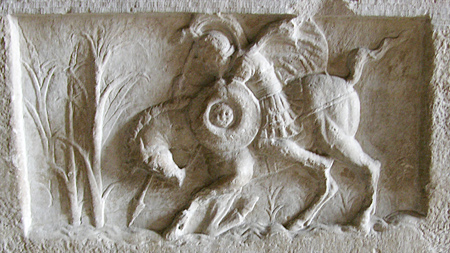

The origins of the shrine of the Lacus Curtius are hopelessly mired in obscurity. One legend of the story has the shrine named for the Sabine leader Mettius Curtius who, during the Roman war with the Sabines, stumbled into a swampy area in the Forum on his horse. This was before the Forum was drained by the buiilding of the Cloaca Maxima under the Tarquins. He was able to struggle out of the marsh, and the place where he and his horse emerged was later called the Lacus Curtius (Livy 1.12-13), hence the image of the horse on the stele illustrated above. But Livy himself records a counter-legend, by which the shrine was named for a later, Roman Curtius who sacificed himself on that spot in 362 BCE by hurling himself into a gaping chasm that had appeared there, an act called devotio that guaranteed the safety of the state in return for the death of one individual (Livy 7.6). Varro, on the other hand, states (LL 5.150) that the shrine was erected by a Consul named Curtius in the year 445 BCE, because the ground had been struck by lightning.
Suetonius records (Augustus 57) the custom under Augustus of throwing a small coin into the shrine in honor of the welfare of the Emperor.
In historical times the Lacus Curtius was a dry well head that was enclosed by a marble lattice fence, as illustrated below.
